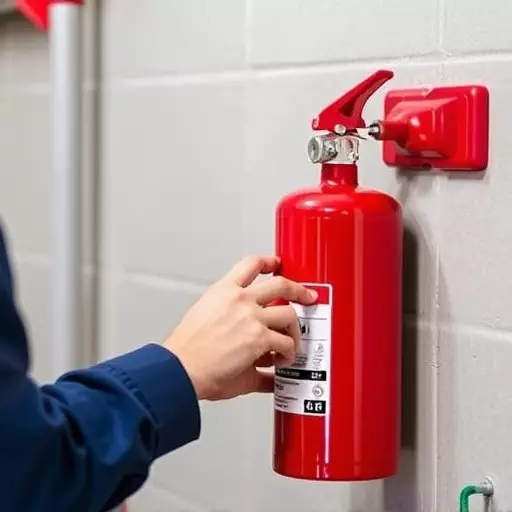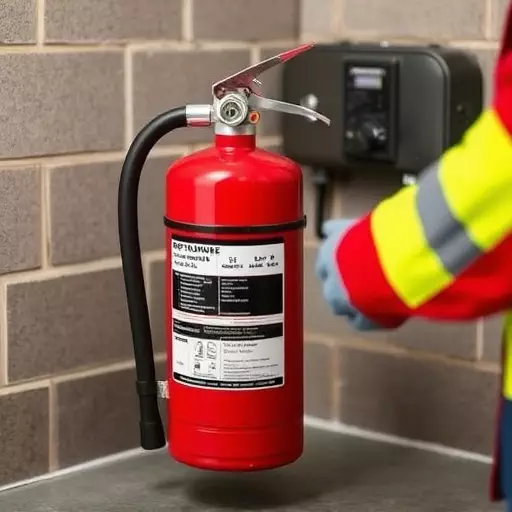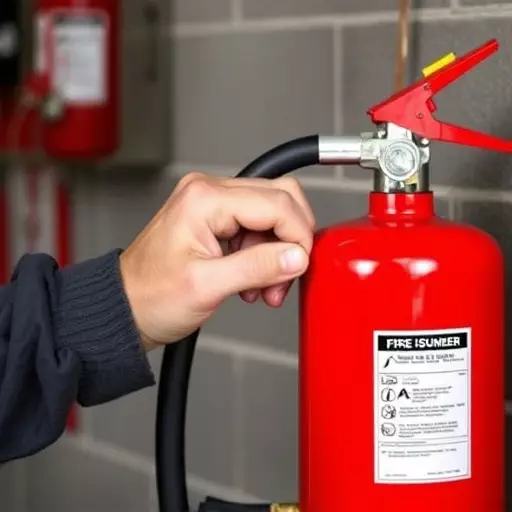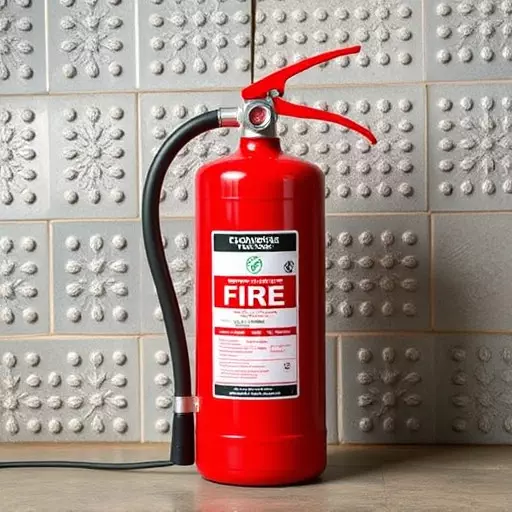In Spring Lake, the Fire Extinguisher Training program is vital for empowering individuals to use fire extinguishers effectively and understand their maintenance. The training includes recognizing signs a fire extinguisher may need repair, such as low pressure, leaks, or operational issues, and emphasizes the importance of routine checks and timely repairs to ensure these safety tools are fully functional in emergencies. Certified professionals should perform regular maintenance, adhering to both the manufacturer's guidelines and local regulations, which typically advise an annual visual inspection and a comprehensive service every 5-12 years. By following this protocol as outlined by Fire Extinguisher Training Spring Lake, residents and businesses can maintain their fire extinguishers' optimal performance, ready to address fires promptly and safely.
Ensuring the safety of individuals and properties against unexpected fires is a paramount concern in Spring Lake. A critical component of this fire safety strategy involves maintaining operational CO2 fire extinguishers. This article delves into the essential aspects of repairing these vital safety devices, from understanding their role to conducting regular maintenance checks. We’ll guide you through identifying signs that signal your CO2 fire extinguisher may need attention, followed by a comprehensive step-by-step repair process. Additionally, we will help you navigate the process of sourcing the correct parts for your specific model and shed light on the intricate components that make up these fire safety tools. For those looking to enhance their preparedness against fires, Fire Extinguisher Training in Spring Lake is an indispensable resource to ensure efficiency and effectiveness when responding to emergencies. Regular inspections and servicing are key to maintaining peak performance of your CO2 fire extinguisher, safeguarding your well-being and property.
- Understanding CO2 Fire Extinguishers: The Role and Functionality in Spring Lake Fire Safety
- Identifying Signs of Wear and Tear in CO2 Fire Extinguishers
- Step-by-Step Guide to Repairing Your CO2 Fire Extinguisher
- Locating the Right Parts for Your CO2 Fire Extinguisher Model
- Demystifying the Components of a CO2 Fire Extinguisher and Their Maintenance
- Fire Extinguisher Training in Spring Lake: Enhancing Safety and Efficiency
- Maintaining Peak Performance: Regular Inspections and Servicing of Your CO2 Fire Extinguisher
Understanding CO2 Fire Extinguishers: The Role and Functionality in Spring Lake Fire Safety

CO2 fire extinguishers play a pivotal role in fire safety, particularly within high-risk environments such as Spring Lake. These extinguishers are designed to target and suppress flaming fires by discharging a clean agent that effectively breaks the chemical chain reaction of a combustion process. Understanding their role is essential for both personal safety and effective fire response strategies in the community. For instance, during Fire Extinguisher Training Spring Lake, residents learn the proper usage of CO2 extinguishers, which is crucial given their unique functionality.
Regular maintenance and timely repair are critical to ensure these life-saving tools function correctly when needed. The fire extinguisher repair process involves several steps. Firstly, it’s important to visually inspect the device for any signs of wear, damage, or corrosion. Leaks, nozzle obstructions, and low pressure are common issues that may necessitate repair. A trained professional should handle the repair process, which includes checking the CO2 cylinder, verifying the functionality of the valve and hose assembly, and ensuring the extinguisher holds the appropriate charge. Identifying signs a fire extinguisher needs repair is key to maintaining a reliable defense against fire hazards in Spring Lake. Regular checks for these indicators can prevent malfunctions and guarantee that when an emergency strikes, the CO2 fire extinguishers are ready to perform their vital function.
Identifying Signs of Wear and Tear in CO2 Fire Extinguishers

Regular inspection and maintenance are critical for ensuring that CO2 fire extinguishers function correctly when needed. Fire Extinguisher Training in Spring Lake, or any location, should include not just the operation of the extinguisher but also the recognition of signs that indicate wear and tear. Over time, components such as the cylinder valve, pressure gauge, seals, and nozzle can degrade, affecting the extinguisher’s performance. A key aspect of the fire extinguisher repair process is to identify these subtle indicators before an emergency arises. Visual inspections should be conducted frequently to check for corrosion or damage on the exterior of the cylinder, as well as any dents or cracks that could compromise its integrity. The pressure gauge must be monitored to ensure it indicates the correct pressure; a significant deviation from the manufacturer’s specified range is a clear sign a fire extinguisher needs repair. Additionally, listen for any unusual sounds during the discharge test, as this can signal internal component issues. It’s important for trained personnel to be aware of these signs and understand the repair process to
Step-by-Step Guide to Repairing Your CO2 Fire Extinguisher

When encountering a fire emergency, a well-maintained CO2 fire extinguisher can be your first line of defense. Regular upkeep is crucial to ensure its efficacy, and part of this involves understanding the repair process. If you notice any of the signs a CO2 fire extinguisher might need repair—such as leaking chemicals, an inability to discharge, or a charge indicator that doesn’t show green—it’s time to act. The repair process is straightforward but requires precision and care. Begin by discharging any remaining contents if the extinguisher is not fully charged. Next, inspect the pressure gauge, hose, and nozzle for damage or obstructions. Clean the components with manufacturer-approved cleaning agents, ensuring all parts are free from debris that could impede function. Check the seals and O-rings for wear, as these are critical for maintaining pressure within the extinguisher. Replace any faulty components immediately. Refill the tank with CO2 only when all parts have been inspected and confirmed to be in working order. Finally, test the fire extinguisher by discharging it in a safe, controlled environment as part of Fire Extinguisher Training Spring Lake. This step is essential to confirm that the repair was successful and that the fire extinguisher is ready for use in an emergency situation. Remember, regular servicing and understanding the fire extinguisher repair process can be lifesaving; it’s a skill that should be familiar to everyone in a high-risk environment. Always refer to the manufacturer’s guidelines when performing any repairs or servicing on your CO2 fire extinguisher.
Locating the Right Parts for Your CO2 Fire Extinguisher Model

When the need arises to perform repairs on a CO2 fire extinguisher, locating the precise parts for your specific model is paramount. This ensures that the repair process aligns with the manufacturer’s guidelines and maintains the integrity of the equipment. Homeowners, business owners, and facilities managers in Fire Extinguisher Training Spring Lake can attest to the importance of proper maintenance. To initiate the fire extinguisher repair process effectively, start by identifying the make and model of your CO2 fire extinguisher. This information is critical when sourcing components such as cartridges, seals, or pressure gauges. The manufacturer’s manual often provides detailed schematics and specifications for each part, which can be invaluable when shopping for repairs.
The signs that a fire extinguisher needs repair are not always obvious but should never be overlooked. A clear indicator is a low-pressure warning, typically displayed through a gauge or a visual inspection showing the pressure is below recommended levels. Another sign is a leaking cartridge, which can compromise the effectiveness of the extinguisher and pose safety risks. If the pin or tamper seal is missing, it’s essential to replace them immediately as they are safety mechanisms designed to prevent accidental discharge. Additionally, if the fire extinguisher does not discharge correctly during a test, this could signal internal issues that require professional repair. For those who have undergone Fire Extinguisher Training Spring Lake, these signs will be familiar, and the importance of prompt action will be clear. It’s advisable to consult with certified professionals or refer to the manufacturer’s guidelines when in doubt about the repair process. Ensuring your CO2 fire extinguisher is fully operational can mean the difference between a contained fire and one that escalates out of control.
Demystifying the Components of a CO2 Fire Extinguisher and Their Maintenance
When it comes to maintaining the safety of properties and individuals, understanding the components of a CO2 fire exinguisher and their upkeep is paramount. A CO2 fire extinguisher, often used for Class B and C fires involving flammable liquids and electrical equipment, contains pressurized carbon dioxide within a cylinder. The primary elements to focus on during maintenance are the pressure gauge, carbon dioctor valve, seals and fittings, CO2 cylinder, and discharge horn. Regular checks should include inspecting the pressure gauge to ensure it indicates correct pressure, verifying that all seals and fittings are intact without cracks or signs of wear, and confirming the functionality of the carbon dioxide valve. It’s crucial to test these components periodically as part of the fire extinguisher repair process, which adheres to industry standards and guidelines, such as those outlined in Fire Extinguisher Training Spring Lake programs. Recognizing the signs a fire extinguisher needs repair is essential for preventing malfunctions during an emergency. These include low pressure readings on the gauge, leaking from any of the seals or fittings, difficulty in operating the valve, and a damaged CO2 cylinder. By staying vigilant and conducting regular maintenance checks, one can ensure that their CO2 fire extinguisher is prepared to function effectively when needed, thereby contributing to a safer environment for all. Regular servicing by certified professionals familiar with Fire Extinguisher Training Spring Lake protocols should be scheduled annually or as recommended by the manufacturer to maintain optimal performance and readiness.
Fire Extinguisher Training in Spring Lake: Enhancing Safety and Efficiency

In Spring Lake, ensuring that the community is well-equipped to handle emergencies is paramount. Fire Extinguisher Training in Spring Lake plays a critical role in enhancing safety and efficiency when it comes to fire-related incidents. This training goes beyond theoretical knowledge; it involves practical demonstrations and hands-on practice with fire extinguishers, which are vital tools in the event of an outbreak. Participants learn the correct procedures for using different types of fire extinguishers, as well as when it is necessary to proceed with a fire extinguisher repair process. Recognizing the signs that a fire extinguisher needs repair is equally important; these include a low-pressure gauge, an unusual sound or behavior during discharge, difficulties in operating the extinguisher due to worn-out parts, and any visual indication of leaks or corrosion on the cylinder. Regular maintenance and timely repairs by certified professionals ensure that these lifesaving devices function correctly when needed most.
A well-maintained fire extinguisher is a key component in mitigating fire risks. In Spring Lake, the local authorities emphasize the importance of regular inspections and prompt repair or replacement as necessary. The training sessions not only cover the operational aspects but also the preventive maintenance required to keep fire extinguishers in optimal condition. Understanding the repair process is essential for anyone responsible for the upkeep of these devices. It involves a systematic approach that includes inspecting the pressure, checking for any external damage, testing the operation of valves and seals, refilling if necessary, and ensuring that all parts are functioning correctly. This meticulous process is designed to restore the fire extinguisher’s effectiveness and reliability, thereby saving lives and protecting property in the event of an emergency.
Maintaining Peak Performance: Regular Inspections and Servicing of Your CO2 Fire Extinguisher

Regular upkeep of CO2 fire extinguishers is paramount to ensuring they function effectively when needed. According to Fire Extinguisher Training Spring Lake, a well-maintained fire extinguisher is a reliable safeguard against unexpected blazes. The fire extinguisher repair process involves several critical components that must be inspected and serviced periodically. These include verifying the integrity of the cylinder, checking the functionality of the pressure gauge, and ensuring the CO2 contents are at the appropriate charge level. A key sign a fire extinguisher might need repair is if it fails to discharge correctly during a test, indicating potential issues with its valve or seals. Additionally, physical damage, corrosion, or leaks must be addressed immediately, as these can compromise the entire system’s performance. To maintain peak performance, adhering to the manufacturer’s guidelines and local regulations for regular inspections is essential. This typically involves a visual inspection followed by a detailed service every 5-12 years, depending on the fire extinguisher type and usage frequency. By implementing a routine maintenance schedule, you can significantly reduce the risk of equipment failure and ensure your CO2 fire extinguisher stands ready to tackle fires effectively when they occur.


